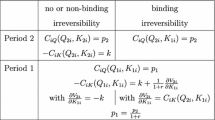Abstract
We examine the incentives that firms have to invest in cleaner abatementtechnology when the banking of permits is allowed in emission permittrading schemes. We show that under certainty permit banking can distortincentives for investment and lead to a sub-optimal amount of investmentspending. Under imperfect information, aggregate abatement costuncertainty and investment irreversibility provide arguments for allowingbanking. We generalize the model to consider these, showing that somebanking is desirable but that it need not be the case that the privatebanking solution is optimal.
Similar content being viewed by others
References
Biglaiser, G. and J. K. Horowitz (1995), ‘Pollution Regulation and Incentives for Pollution-Control Research’, Journal of Economics and Management Science 3, 663–684.
Bohi, D. R. and D. Burtraw (1997), ‘SO2 Allowance Trading: How Experience and Expectations Measure Up’, Resources for the Future Discussion Paper 97, 24.
Burtraw, D., C. Carlson, M. Cropper and K. Palmer (1997), ‘Econometric Estimates of SO2 Abatement Costs Under Title IV’, Proceedings of AWMA/Acid Rain Electric Utilites Conference.
Calfornia Air Resource Board (1990), Proposed Regulations for Low-Emission Vehicles and Clean Fuels. CARB staff report.
Cronshaw, M. B. and J. B. Kruse (1996), ‘Regulated Firms in Pollution Markets with Banking’, Journal of Regulatory Economics 9, 179–189.
Godby, R.W., S. Mestelman, R. A. Muller and J. D. Welland (1997), ‘Emissions Trading with Shares and Coupons when Control over Discharges is Uncertain’, Journal of Environmental Economics and Management 32, 359–381.
Innes, R. and J. Bial (2001), Inducing Innovation in the Environmental Technology of Oligopolistic Firms. University of Arizona at Tucson, mimeo.
Joskow, P. L., L. Schmalensee and E. M. Baily (1998), ‘The Market for Sulfur Dioxide Emissions’, American Economic Review 88, 669–685.
Jung, C., K. Krutilla and R. Boyd (1996), ‘Incentives for Advanced Pollution Abatement Technology at the Industry Level: An Evaluation of Policy Alternatives’, Journal of Environmental Economics and Management 30, 95–111.
Kling, C. L. and J. D. Rubin (1997), ‘Bankable Permits for the Control of Environmental Pollution’, Journal of Public Economics 64, 101–115.
Kneese, A. and C. Schultze (1978), Pollution, Prices, and Public Policy. Washington, D.C.: Brookings Institute.
Leiby, P. and J. Rubin (1998), Bankable Permits for the Control of Stock and Flow Pollutants: Optimal Intertemporal Greenhouse Gas Emission Trading. Draft Manuscript.
Milliman, S. R. and R. Prince (1989), ‘Firm Incentives to Promote Technological Change in Pollution Control’, Journal of Environmental Economics and Management 17, 247–265.
Orr, L. (1976), ‘Incentives for Innovation as the Basis of Effluent Charge Strategy’, American Economic Review 56, 441–447.
Rubin, J. D. (1996), ‘AModel of Intertemporal Emission Trading, Banking, and Borrowing’, Journal of Environmental Economics and Management 31, 269–286.
Rubin, J. D. and C. L. Kling (1993), ‘An Emission Saved is an Emission Earned: An Empirical Study of Emission Banking for Light-Duty Vehicle Manufacturers’, Journal of Environmental Economics and Management 25, 257–274.
Requate, T. (1998), Does Banking of Permits Improve Welfare? Draft manuscript, Department of Economics, University of Heidelberg.
Schmalensee, R., P. L. Joskow, A. D. Ellerman, J. P. Montero and E. M. Bailey (1998), ‘An Interim Evaluation of Sulfur Dioxide Emissions Trading’, Journal of Economic Perspectives 12, 53–68.
Yates, A. (2001), ‘Pollution Permit Market with Intertemporal Trading and Asymmetric Information’, Journal of Environmental Economics and Management, forthcoming.
Author information
Authors and Affiliations
Corresponding author
Rights and permissions
About this article
Cite this article
Phaneuf, D.J., Requate, T. Incentives for Investment in Advanced Pollution Abatement Technology in Emission Permit Markets with Banking. Environmental and Resource Economics 22, 369–390 (2002). https://doi.org/10.1023/A:1016097000190
Issue Date:
DOI: https://doi.org/10.1023/A:1016097000190




